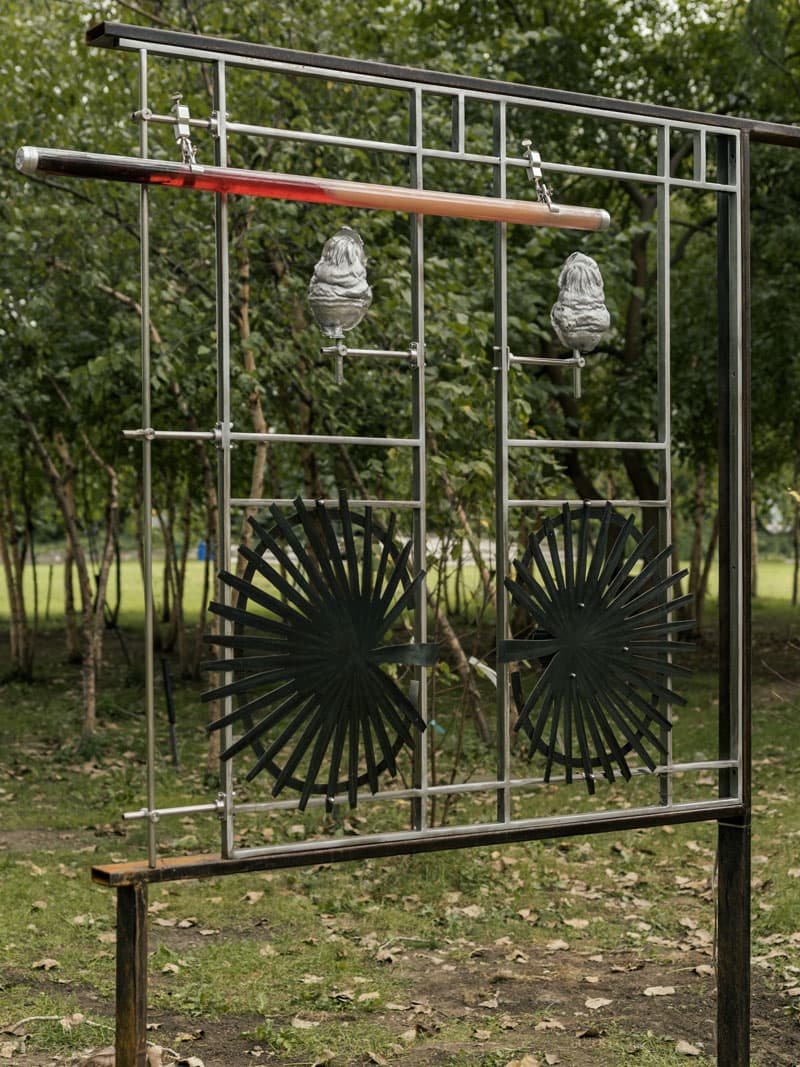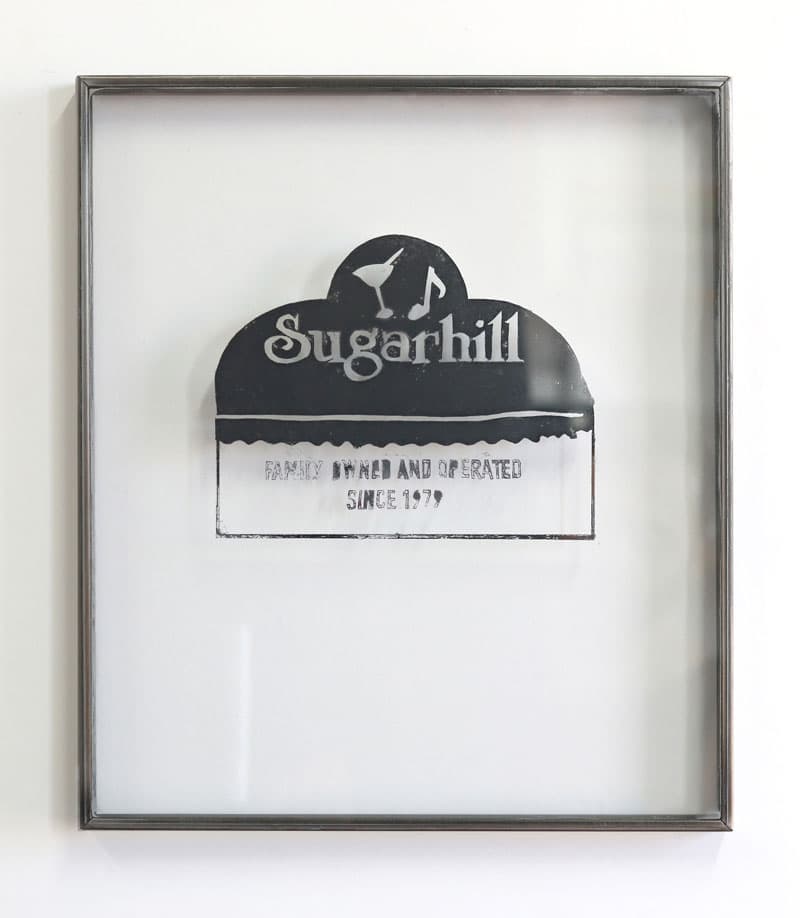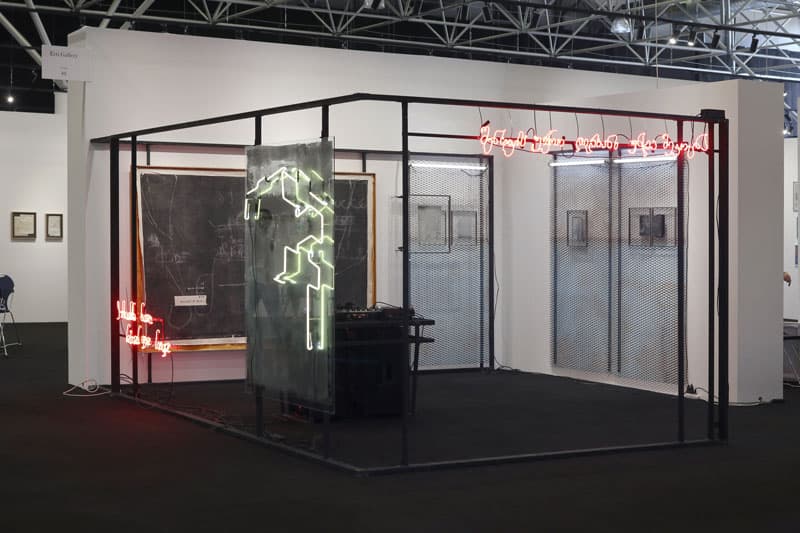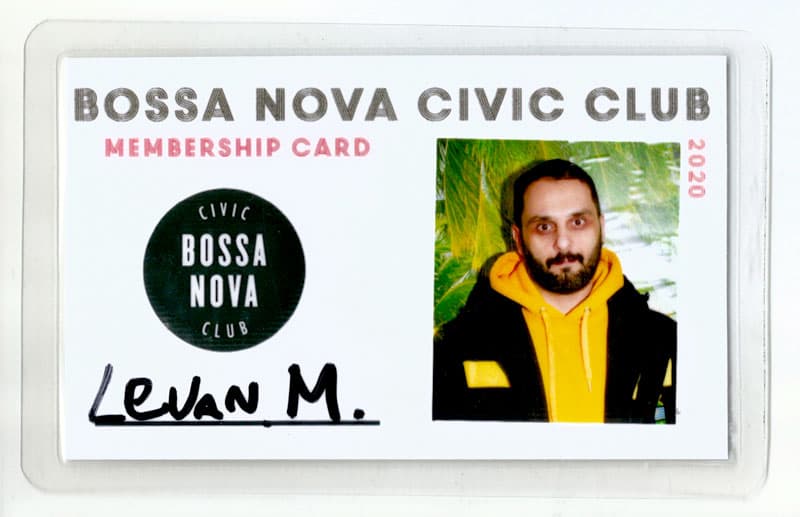Published July 29, 2022
Archives, The Dance Floor, and Using Art to Rethink Binaries: An Interview with Levani
Levani (Levan Mindiashvili) is a Tbilisi-born, Brooklyn-based trans-disciplinary artist. They create immersive installations, two-dimensional images, sculptural objects, and neons that explore the psychological dimensions of current geopolitical shifts and socio-cognitive dislocation. Informed by their interest in cosmology, neuroscience, biology, and epistemology, Levani’s work invokes a post-binary, pluriversal alternative to human-centric, dualistic perspectives. Levani is a graduate of Tbilisi State Academy of Fine Arts (1997-2003) and the National University of Art of Buenos Aires (IUNA, Postgraduate Studies in Combined Artistic Languages, 2008-2010).

I want to start with your piece 127.1 bpm (for my dancing peers) from 2021 that was shown at Socrates Sculpture Park. Can you walk me through the materials and what they reference?
LM: I wanted to do something with electronic music and dance from the very first day I started going out in the mid 2000s, but it took me a pretty long time to figure out what to do and how to do it. The first works started to emerge in 2019. I showed I should have kissed you longer, which was a solo presentation with ERTI Gallery at the Tbilisi Art Fair. That was followed by the set of seventeen mirror paintings titled 89.19 at the Berlin Art Fair. These two projects emphasized the role of dance as a form of political activism and resistance in my native Georgia and how the underground dance scene impacted societal changes in the last decades. Following them, Levani’s Room: HOME happened at SPRING/BREAK 2020 right before lockdown, which was specifically about New York’s underground spaces.
The Socrates sculpture in 2021 allowed me to widen my inquiry and not be so specific about the place(s) or the industry itself, and instead think about the dance floor in its broader sense. Socrates’ Open Call was centered around a Sanctuary, so I wanted to emphasize that idea of a sanctuary not as a physical space, a destination or escape, but as a threshold for dancers. Even the title 127.1 bpm emphasized the dancers—the ones inhabiting the dancefloor. Not only is the dance floor a physical space, it’s a psychological space, even spiritual to me. I think of it like a threshold, like a temporary site of transformation. This thinking became a point of departure to talk about the underground.
For the materials, 127.1 bpm was inspired by Bossa Nova Civic Club in Bushwick and its cast iron gates that separate the bar from the dance floor. It’s this beautiful structure adorned with cast iron palm tree leaves. In the beginning, I was planning to acquire or rent the club’s gates and install them at the sculpture park, because we were still in lockdown, the clubs were shut down, and I was thinking those funds could be of some help for the staff. But by the time the fellowship started, in May of 2021, all the venues reopened, so I had to search for another path. I ended up creating my own gates in order to emphasize the concepts of thresholds and transformation.
My sculpture is a two-part “gate.” The first tier repeated the original design with metal palm tree leaves, while the second higher tier hosts palm tree buds casted in silicon and stainless steel powder. I attached the speakers to the palm trees, where the sound was circulating, created with the sound artist Bryce Hackford and DJ dr. fruit. Despite the fact that the sound was pre-recorded, it had this interactive quality to it, and it was very interesting to see how people would react or even dance to it.
The piece sounds like it functions as an archive to the iconography of New York dance floors, especially Bossa Nova Civic Club. Do you feel like the work functions in that way? If so, do you think that reading could strengthen over time?
LM: Yes and no. I think there’s a stronger archival quality in some of my other works, like HOME EP. That series was conceived as an archive of a very specific experience I had in New York. I started going out and discovering electronic music at the same time I was coming out, so the dance floor became where I learned about myself, discovered myself, accepted myself, and learned my own body language and the things it can communicate for the first time. They’ve also always been small, underground venues no matter where I’ve lived, like Buenos Aires’ Bahrein, which was twenty minutes from my place when I lived there, or Bossa Nova, which is five minutes from my current apartment in New York. Those spaces were extremely important to me. They became a place where I would just stop by and see what was happening, really becoming my home. That’s why HOME EP juxtaposes pictures of my actual apartment with architectural details, and mailing lists, and logos of venues and events of New York.
But at the same time, I knew I wasn’t working on an “objective” archive of New York’s music scene. I created a very subjective, very personal story of a queer immigrant. That said, I knew others would relate to some aspects of my story.

Did you find it difficult to lose the dance floor early in the pandemic?
LM: It was difficult, but if I can be very honest, I was already starting to lose it before the pandemic.
When I started to dive deeper into the underground and make work about it, I was thinking about its spiritual and psychological aspects all the while unfolding its aspects as an industry as well. That's when I saw aspects of disillusionment start to emerge, almost like I began to understand the power dynamics at play and how it's actually structured around heteronormative capitalist greed.
I think this disillusionment is important to mention because we're talking about a specific context—21st century New York nightlife. We’ve witnessed a true commercialization, even gentrification, of the underground in the past 15, 20 years. And just two years into an ongoing pandemic, we’re back to having, like, twenty parties a weekend.
LM: Yes. I also want to separate “nightlife,” which is a mainstream business, from the “underground queer scene,” which has proven to be more fragile cannot exist within the same “nightlife” industry. This became much more clear to me after the so-called “reopening” in 2021. We had such a collective moment of awakening and radicalization in 2020. 127.1 bpm served as a way for me to rethink the underground.
To be honest, I believe that we, the queer power, cannot stay underground anymore. We need to bring the underground up from the ground and make it more accessible. Can we make these spaces safer? Can we better display care? And can we mobilize at the same time? But instead of answering these questions, there was this urgency to recreate clubs as they were before. It happened all of a sudden, and felt very forced to me, even insensitive.
Why do you think it was especially hard for queer people to lose the dance floor in 2020?
LM: There’s a quote by Luis Manuel Garcia-Mispireta in the “Rave Scout Cookies #001 Handbook,” where he says:
At the beginning of the 1970s in New York City, queers of African-American and Latin-Caribbean (primarily Puerto Rican) descent, drag queens of many shades, and straight-but-not-narrow allies came together to create small pockets of space in the urban landscape where they could be safe… and be with others in ways not permitted in the wider world structure as it is by heteropatriarchy and white supremacist.
Queer spaces were originally small, safe pockets that allowed us to create different ways of communicating and relating to each other outside of heteropatriarchy. That’s why the pandemic closures were so emotional for us. Technically, as queer people, we don't have any space for ourselves. The rare spaces we do have are sources of community, and even income, for us, but they can be taken away at any time. Our income can then quickly become profit for someone else who exists outside of our community.
It becomes so obvious when this outside world comes in. It’s pretty violent. That’s why we need to create spaces where we care for each other. But my question is: is the dance floor still that space? Or do we need to rethink where we care for one another?
I want to turn back to the palm leaves and their buds that appear in your work. They seem to be a visual leitmotif the past few years. I'm not only thinking of 127.1, but also what if the trees were our lungs? No.2 (2021), where the palms nest (2022), and Me/Mom (2021). What draws you to them?
LM: I was born and raised in Tbilisi, Georgia, where palm trees aren’t part of the everyday, but there were three of them near the building where I lived during my early childhood. Because of the unfavorable, cold winters, someone would cover them in burlap for the entire winter and then open them up again in late spring. So from an early age, they really became a signifier of care to me, and also the symbol of “otherness” and being “different.” The evidence that there was something else other than the world I already knew.
It was incredibly meaningful for me to recognize the palm tree leaves on the gates at Bossa Nova. It’s funny, actually, because when I talk to people who have been there a lot, not many see them as palm trees. They’re interpreted as other objects because they’re pretty abstracted.

LM: As the time passed by, I became more interested in studies like ecology. I followed my intuition and took some time to research palm trees. Eurasian cultures, for example, have many historical meanings for palm trees. It was considered the symbol of eternal life. There’s also this exotizied Western vision of the tree; they play this role of paradise or a better place that we long for. But it turns out the palm tree is one of the oldest plants on our planet. They’re also not necessarily trees, they’re plants. So it’s interesting to see how they carry the history of life on Earth, and the things we could learn from them.
The buds showed up the first time I went to Florida at the end of 2020, where I started collecting and casting them in different materials. I look at them as the carriers of new life, and when I used them in 127.1 bpm, I wanted to open up a conversation about ecology as a site of rebirth and healing. They became not only an entry point to Socrates Sculpture Park, but also a method to develop a lexicon, or a language, to help me talk about these larger concepts.
I'm glad you're bringing up this concept of building language and symbols. I tend to link a lot of your work with semiotics—the study of signs and symbols. Do you think it's fair to say your work functions as a language meant to complicate histories and binaries?
LM: Yes, but my approach has changed over the years. Now, as I’m developing these objects as symbols, I'm looking at the quality of the icon, or archetypical image, that the viewer can relate to through cognition or intuition. It’s about finding something that is both easily recognizable but could also be jarring and raising questions. For example, you could just have the coconut as it is, next to its cast in silicon the color of my skin—which makes it look like a human organ basically—or resin, or stainless steel. The same object in different materials speaks about different material embodiments and inspires different readings. As we talk about the exhaustion of binary systems as opposing dichotomies, like “nature” versus “synthetic,” I hope these objects make this collapse even more evident.
I go back to HOME EP, that set of mirror paintings that depict the logos and flyers of venues that I used to visit. They were meant to be this very coded archive for my community, and I was not really thinking of how it would be read by the wider audience. One of them is a very abstracted image of a light fixture at a venue in South Brooklyn. Some of the first people I showed the work to were friends I met dancing, and they immediately recognized it as the lights of the club Analog. It meant the audience the pieces were meant for actually got it.
But from there, I moved out slowly, creating more complex iconography about binaristic systems. I think of my recent work as riddles, where the objects are recognizable, but their meaning is complicated by the relationship between the viewer and the piece.
It makes me think about the history of flagging—a signal for queer people to understand that the rest of the world wouldn’t even notice. Part of me would argue your palm leaves build from that legacy of crafting our own languages outside of binaries.
LM: Exactly. The need and urgency of doing so is even bigger now, you know, because we’re facing so much polarization. I’m critical of contemporary identity politics, which to me isn’t really helpful because individuals become reduced to the pre-defined experiences. It almost completely denies cross-pollination, and we lose the ability to talk about complex experiences.
What I'm trying to do with my work instead is develop signs and symbols of kinship and belonging. That’s what I think is the biggest value of archives. They build a legacy of belonging from one generation to another, which creates a sense of continuity and care, which we really need, especially right now.
Do you think there's power in queer people crafting language or signals that we only see or understand?
LM: What was really important for thinking through 127.1 bpm was an interview with Simon Lee. Very early in her career, she openly stated she's making work primarily for Queer Black Women. People were very surprised by how she narrowed down her audience at such a young age. But her statement really helped me see who my primary community is, and whom I’m talking to. It’s a sense of community, and takes away the concept of the individual artist. We are an ecosystem of interdependence, right? We have to understand that's true for our communities and that's true for queer people. We’re one big network of interdependency, and we need the language to communicate to each other that won’t divide us but instead bring us closer.
What other archives or histories have you been digging into this year? Anything you want to incorporate in the future?
LM: I’m learning more about how humans are organized around ideals and belief systems, which historically have been pretty hierarchical. I want to learn how to build non-hierarchical structures. I’m fascinated by the materiality of the universe and by the intelligence of all life forms. And while exploring the idea that we’re all constituted of the same matter, I ask myself: how can we access those intelligences embedded within our bodies? I’m digging into everything from Indigenous cosmology to epigenetics and microbiology, because these studies and knowledge sets seem to be unraveling and unfolding the same truths about interdependency.
It makes me think of my bet that the future we need not only celebrates the future but also the ancient—not only the new, but the old.
LM: Absolutely. You know, a few weeks ago, I actually discovered for myself that I’m really an archaeologist of knowledge right now. I really dislike the term “knowledge production,” not only because it’s pretentious, but it also has this capitalist production orientation. I’m also very skeptical of the modernist fetish of the “new.” A lot of these “new” worldviews are partially the same beliefs built from different tools and different systems. What is actually new are the tools like advanced science or expanded concepts of justice that create a more holistic image of the world. The truth, or the knowledge, is out there. But humans have a hard time seeing it. It unfolds as we learn to see it.

You’ve mentioned in the past that the dance floor is not a destination, but a portal. Do you think one day the dance floor could actually take us to a queer future?
LM: Yes. I believe it’s the natural evolution of the world, or the cosmos, or whatever you want to call it. It just unravels and expands itself. These centuries-old, widely accepted, binary worldviews and foundations have been proven to just be physically not true. They will eventually be completely exhausted. Even for me personally, I’m very cautious right now about the term non-binary, because I don’t want to be defined by the prefix “non.” This is a transitional moment for me where I’m divorcing from the binary system and stepping into something new. I don’t want to frame myself as a pre-existing concept. It’s like the act of queering, which provides us with the tools to create entirely new sets of categorizations.
Testudo is always looking for more voices to write with us about the art world. If you’d like to pitch an article, please see our pitch guide for more information!